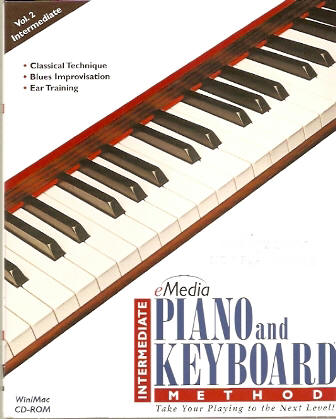|
|||
s with the beginning eMedia Piano and Keyboard Method, the Intermediate Piano and Keyboard Method shows every indication of having been created by someone with a solid and comprehensive knowledge of music and thoroughly professional teaching skills. It's author, Vadim Ghin, holds a Master of Music degree from Juilliard, and has taught there and in other prestigious music schools. This program really is designed for students at the intermediate level who have a good foundation of early training. It may be considered as a "follow-on" to the eMedia Piano and Keyboard Method, reviewed earlier on PEP.
|
|||
|
There are more than 150 individual lessons, with a lot of emphasis on pure finger technique throughout. It is important to understand that this program really is designed for students at the intermediate level who have a good foundation of early training. The first section, comprising 24 lessons, deals with basic knowledge of pitches and intervals, but there is a lot else along the way. First, the student gets to read two full screens of music history outlining the development of tonality from the ancient Greeks through the Renaissance, with references to acoustical properties such as fundamentals and overtones, plus consonance, dissonance, scales and modes, Gregorian Chant, Pythagoras, Palestrina, Plato, and Aristotle. The first composition assigned is a Trio in A Minor by Beethoven which calls for shifting and extended hand positions, legato and staccato touches, phrasing, dynamics, and accents. Subsequent sections are equally thorough. Section Two, "Developing Manual Dexterity and Independence", continues with two screens showing the rhythmic values of notes and rests (all the way through 64ths), and wastes no time in putting the student's hands to work. Our old friend Hanon shows up, along with other finger exercises, independence of hands, skips, and various touches. In the introduction to an arrangement of part of Beethoven's Ecossaise in E-flat--only the second composition in the entire program--we read: "In the following piece you will find yourself skipping around a lot. Notice that both hands have jumps--sometimes just jumping on the same note (but changing fingers), and sometimes even jumping up an octave and back down." Section Three takes the student into some very advanced and tricky rhythms. One learns to divide beats into not only duplets and triplets, but fives and sevens, while complex rhythmic combinations, time signatures which change during the piece, and difficult music like Debussy's Prelude to the Afternoon of a Faun" are presented. On the technical side, special attention is given to what is called "pivoting on the thumb." We find this to be an unfortunate label for connecting hand positions with the thumb, and no further explanation of the actual movement is given. If the author really means to use the thumb as a miniature pole vault for a twisting hand instead of passing it under independently, then it is our opinion--and that of legions of other pianists and teachers--that the term describes precisely what the hand should not do. Subsequent sections take the student further into interpretation, dealing with expression marks, varied sonorities such as open and closed voicing, harmony and scale resources, rubato, and more sophisticated dynamics and touches. Sections Six and Seven move into blues, jazz, swing, and other traditional popular styles, and the final section is given over to the piano in ensemble playing, both in jazz and in classical concertos with orchestra. There are three appendices. Appendices A and B continue with pure technique: more advanced exercises, including some by Hanon and Isidor Philipp, the major and minor scales, and extended intervals. Appendix C gives a review of basic materials covered in the earlier eMedia program for beginners. eMedia Intermediate Piano and Keyboard is decidedly not for beginners. It seems designed for serious students who have not only a good start in piano instruction, but something of a general familiarity with the musical language and the standard repertoire as well. Teachers who wish to use it in their studios should know that, unlike in some other programs, there is no provision for setting up individual lesson plans for different students. An educational edition is available for teachers of piano, which includes student tracking and network capability, among others. Despite the few misgivings mentioned above, we heartily commend the author for marketing a no-nonsense program that assumes intelligence and aptitude on the part of its users. A free downloadable demo version can be obtained from the eMedia web site. William Leland eMedia Intermediate Piano & Keyboard Method. $59.95. eMedia Music Corporation, 664 NE Northlake Way, Seattle, WA 98105. Tel. 206-329-5657; Fax 206-329-0235. WWW: http://www.emediamusic.com. E-mail: custserv@emediamusic.com. Minimum system requirements: Windows: Pentium PC, Windows 95/98/2000/Me/XP, 32 MB free RAM, CD-ROM. Macintosh: Power PC, System 7.5.1+ or OS X 10.2+,32 MB free RAM,CD-ROM. |
||
|
Page
created: 3/27/07 Last updated: 02/09/24 |

 Review of eMedia
Intermediate Piano & Keyboard Method
Review of eMedia
Intermediate Piano & Keyboard Method
 In fact, the eMedia
Intermediate Piano & Keyboard Method as a whole has a comprehensiveness that could well
be daunting to users who are looking for a simple, direct approach to
playing. This by no means implies that the method is hard to navigate, or
that all instructions are not clear and precise. But some users may find
what seems to them a bewildering array of options, alternate techniques,
illustrations, explanations, and references. On learning a new song, for
example, the student may click to hear an audio of it, watch a video of it
being played, activate both hands or the left or right hands separately,
view the score, vary the tempo, add a metronome track, listen to an
instructor's spoken comments, and, in some cases, even learn a bit of
relevant music history. In the Options menu, Preferences lets you "set
highlighting and selection colors, recording quality and keyboard options,
including keyboard tracking synchronization." When using an optional MIDI
compatible keyboard, you can get feedback on mistakes made. eMedia advertises
the program as "a comprehensive musical experience", and it certainly is
that.
In fact, the eMedia
Intermediate Piano & Keyboard Method as a whole has a comprehensiveness that could well
be daunting to users who are looking for a simple, direct approach to
playing. This by no means implies that the method is hard to navigate, or
that all instructions are not clear and precise. But some users may find
what seems to them a bewildering array of options, alternate techniques,
illustrations, explanations, and references. On learning a new song, for
example, the student may click to hear an audio of it, watch a video of it
being played, activate both hands or the left or right hands separately,
view the score, vary the tempo, add a metronome track, listen to an
instructor's spoken comments, and, in some cases, even learn a bit of
relevant music history. In the Options menu, Preferences lets you "set
highlighting and selection colors, recording quality and keyboard options,
including keyboard tracking synchronization." When using an optional MIDI
compatible keyboard, you can get feedback on mistakes made. eMedia advertises
the program as "a comprehensive musical experience", and it certainly is
that.